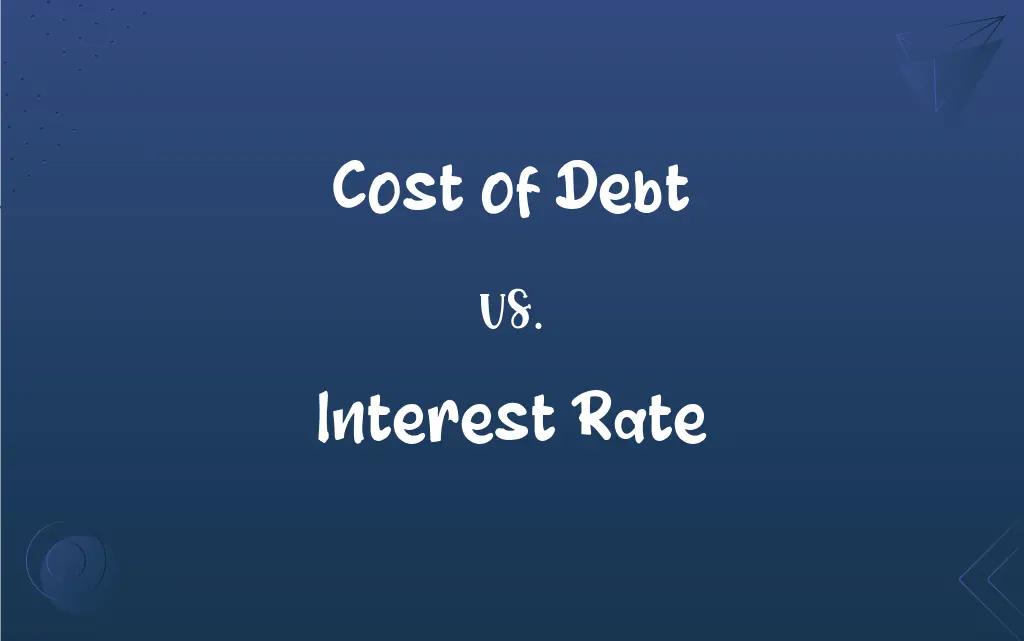Cost of Debt vs. Interest Rate: What's the Difference?
Edited by Aimie Carlson || By Janet White || Published on December 20, 2023
Cost of debt is the effective rate a company pays on its borrowed funds, accounting for tax benefits, while interest rate is the percentage charged on the principal by a lender.

Key Differences
Cost of debt is a comprehensive measure, reflecting the total expense of borrowing including interest and other fees, adjusted for tax implications. Interest rate, in contrast, is simply the percentage charged on the principal amount of a loan or debt.
The cost of debt guides businesses in financing decisions, indicating the true burden of borrowing after tax deductions. Interest rate primarily affects the periodic payments on loans, influencing borrower’s immediate cash outflows.
Cost of debt includes the effect of tax shields, as interest expenses are often tax-deductible, reducing the overall cost. Interest rate itself does not account for tax implications; it is a gross figure before any tax benefits.
In investment analysis, cost of debt is crucial for calculating the weighted average cost of capital (WACC), affecting valuation and investment decisions. Interest rate directly influences the cost of borrowing but is just one component of the broader cost of debt.
Cost of debt can vary based on a company’s creditworthiness and market conditions, providing insight into the risk profile of the company. Interest rate is set by lenders based on factors like credit risk, market rates, and loan terms, and can fluctuate with market conditions.
ADVERTISEMENT
Comparison Chart
Definition
Total expense of borrowing, adjusted for tax benefits.
Percentage charged on the loan principal.
Tax Implications
Accounts for tax deductibility of interest expenses.
Does not include tax considerations.
Role in Finance
Used in calculating WACC and overall financial strategy.
Affects periodic loan payments and borrowing cost.
Calculation
Includes interest, fees, and other borrowing costs.
Calculated as a percentage of principal.
Impact on Companies
Reflects the true financial burden of borrowing.
Indicates the immediate cost of borrowing for a company.
ADVERTISEMENT
Cost of Debt and Interest Rate Definitions
Cost of Debt
Cost of debt is a key metric in corporate finance, indicating the expense of debt financing.
To improve profitability, the firm aimed to lower its cost of debt.
Interest Rate
Variable interest rates fluctuate with market trends, while fixed rates remain constant.
They chose a fixed interest rate mortgage to avoid market fluctuations.
Cost of Debt
Cost of debt is the effective interest rate a company pays on its debts, including bonds and loans.
The company's cost of debt decreased after refinancing at a lower interest rate.
Interest Rate
Interest rate is the percentage charged on a loan or paid on savings and investments.
The bank offered an interest rate of 5% on its new savings account.
Cost of Debt
It represents the total financial charge for borrowing, factoring in fees and tax effects.
Their cost of debt was high due to additional financing fees and higher interest rates.
Interest Rate
It represents the cost of borrowing money or the return on invested funds.
They secured a loan with an interest rate of 7% annually.
Cost of Debt
It is used in calculating a company's weighted average cost of capital (WACC).
The cost of debt was factored into the WACC, affecting the company's investment decisions.
Interest Rate
Higher interest rates make borrowing more expensive and saving more attractive.
The increase in interest rates discouraged businesses from taking out new loans.
Cost of Debt
Cost of debt varies with market conditions and a company’s credit risk.
The economic downturn led to an increase in their cost of debt.
Interest Rate
Interest rates are set by lenders and influenced by central bank policies and market conditions.
The central bank's decision led to a rise in interest rates across the market.
FAQs
Why is cost of debt important in finance?
It’s crucial for assessing the true cost of borrowing and making informed financial decisions.
What factors influence interest rates?
Interest rates are influenced by central bank policies, economic conditions, and credit risk.
What is an interest rate?
Interest rate is the percentage charged on the borrowed principal or earned on deposits.
How is cost of debt calculated?
It's calculated by adding all borrowing costs and adjusting for tax savings.
What does cost of debt mean?
It’s the effective rate a company pays on its borrowings, considering interest, fees, and tax benefits.
Do interest rates affect savings?
Yes, higher interest rates make saving more attractive due to better returns.
Can cost of debt change over time?
Yes, it can change with market conditions, company credit rating, and tax laws.
Is cost of debt the same for all companies?
No, it varies based on a company's creditworthiness and market conditions.
Does inflation affect interest rates?
Yes, central banks may adjust interest rates to control inflation.
Can personal loans have different interest rates from business loans?
Yes, as they are based on different risk assessments and market conditions.
What is a good interest rate for a loan?
A good rate is relative, depending on the market conditions and borrower's credit profile.
Are interest rates fixed or variable?
They can be either, depending on the terms of the financial product.
What’s the relationship between WACC and cost of debt?
Cost of debt is a component in calculating WACC, impacting overall corporate valuations.
Can a company’s actions alter its cost of debt?
Yes, actions affecting creditworthiness or market perceptions can alter it.
How do economic downturns affect interest rates?
Economic downturns often lead to lower interest rates to encourage borrowing and stimulate the economy.
How do central banks influence interest rates?
Central banks set benchmark rates, influencing the rates banks charge on loans and offer on deposits.
How does refinancing affect cost of debt?
Refinancing can lower cost of debt if obtained at a lower interest rate.
Why do interest rates vary between different loans?
Rates vary due to differing credit risks, loan terms, and lender policies.
What tax benefits are associated with cost of debt?
Interest expenses are often tax-deductible, reducing the overall cost.
Is a lower cost of debt always better?
Generally, yes, as it indicates cheaper borrowing costs, but it should also be weighed against investment returns.
About Author
Written by
Janet WhiteJanet White has been an esteemed writer and blogger for Difference Wiki. Holding a Master's degree in Science and Medical Journalism from the prestigious Boston University, she has consistently demonstrated her expertise and passion for her field. When she's not immersed in her work, Janet relishes her time exercising, delving into a good book, and cherishing moments with friends and family.
Edited by
Aimie CarlsonAimie Carlson, holding a master's degree in English literature, is a fervent English language enthusiast. She lends her writing talents to Difference Wiki, a prominent website that specializes in comparisons, offering readers insightful analyses that both captivate and inform.






































































